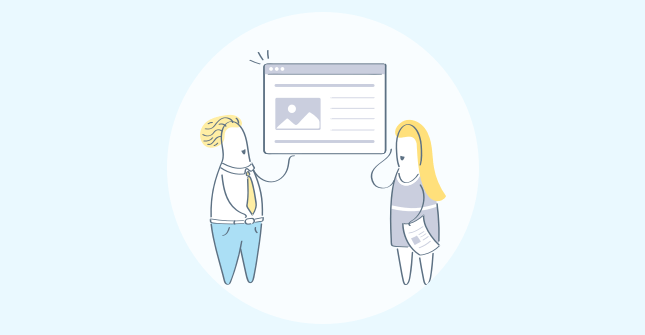Market segmentation is the art of finding and targeting the right audience for your business. And in this article, we’ll make a case for why it’s a critical part of hyper-targeted marketing and personalization processes.
If you are funneling thousands of dollars into your marketing campaigns, isn’t it fair to know that the messaging is reaching the right people?
Because if you don’t find the right prospects, there will be no long-term customers, and it would only increase the acquisition costs without effective ROI. And that’s what market or audience segmentation prevents from happening to you.
It’s also supported by a Mailchimp study which shows that segmented campaigns produce a 100.95% higher click-through rate than non-segmented campaigns.
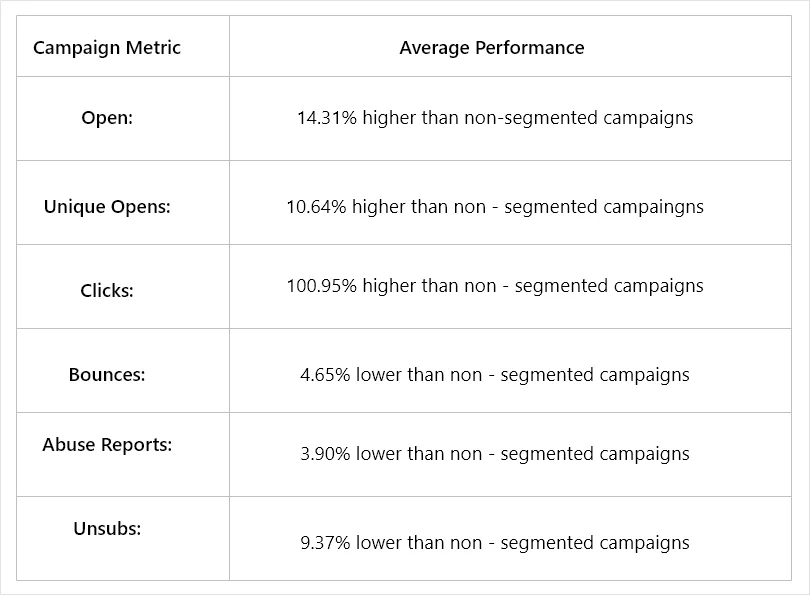
But there’s more to it. Once you have converted the prospects, the same target segmentation model can help you explore opportunities to increase the purchase value of different customer segments by channeling their needs and preferences into your product messaging.
That’s why we have compiled this comprehensive guide to give an in-depth idea of what market segmentation is and how to segment your target market. We have also outlined common mistakes that brands make while performing segmentation analysis so you can avoid them.
What is Market Segmentation: Definition
Market segmentation is defined as the process of categorizing your prospects and customers based on different attributes and characteristics. Each category is called a customer segment or customer persona.
These attributes define each segment’s behavior, shopping pattern, demographics, hobbies, and other traits that businesses channel into various processes.
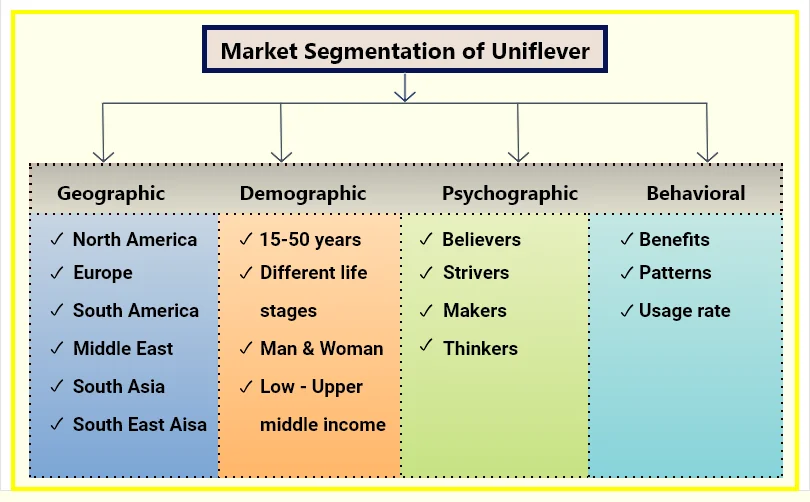
Here is a real-life case study from Canon to illustrate my point:
One fine morning Canon tasked AWA-Digital to gauge its product demand in different geographies to increase overall revenue. AWA-Digital used user research surveys to collect data from prospects and customers from different locations.

It helped the team segment the audience to learn about their preferences, reservations, and purchase behavior. For example, in some regions, users were hesitant to spend too much money on a camera, while in other regions, they were unaware of Canon being a industry leader.
So, AWA optimized elements of Canon’s messaging based on geography to appeal to different customer segments. The result was a 700% ROI across all regions.
From marketing to product development and customer service, market segmentation plays an important part in optimizing and prioritizing key processes.
Importance of Market Segmentation
Market segmentation derives its need from the fact that it lets you see visible trends among the heterogeneous population, making it possible for different teams to focus on individual segments.
So, rather than producing mass marketing campaigns and hoping they appeal to all the customers, you can create smaller, more refined crusades that target a specific segment and are more effective.
Here are few other pointers that exemplify the need for market segmentation:
1. Identify Different Audience Types
The primary purpose of market segmentation is to understand different groups among the target population. It lets the marketing team, product team, UI/UX team, and any other team that deals directly with the customers understand each of these groups’ pain points and delights.
As you learn how each group is different from others, you can come up with solutions that cater to each one of them.
Case Study – Udemy uses customer segmentation to allocate marketing resources and innovate its platform.
Udemy, one of the biggest e-learning platforms, uses user feedback to segment the visitors on its website according to the traffic source. The teams need to know how people land on its pages to allocate the advertising budget accordingly.
Udemy also uses targeted surveys to understand the effectiveness of the advertisement campaigns for different locations. Doing this helps the platform understand how different geographic segments react to different ads.
What’s more, survey feedback helps to understand the pain points of different segments across various locations.
For example, it was observed that people outside English-speaking countries were opting for courses taught in English. Then Udemy’s team launched automatic captioning in the course videos to improve user engagement and content accessibility.
2. Personalize Your Campaigns
There is no one-size-fits-all approach in a business because every customer has different preferences and interests. With market segmentation data comes the power to design a personalized experience for each segment.
Personalization is possible only when you understand the behavior and actions of the people who interact with your business.
In fact, 90% of customers are willing to share behavioral data for an easier and more personalized experience. So, personalization also promotes lead generation.
In a 2018 survey of 455 advertisers, publishers, and tech developers by Winterberry Group, 62% of respondents identified that improving audience segmentation to support more precise ad targeting was the top campaign management priority.
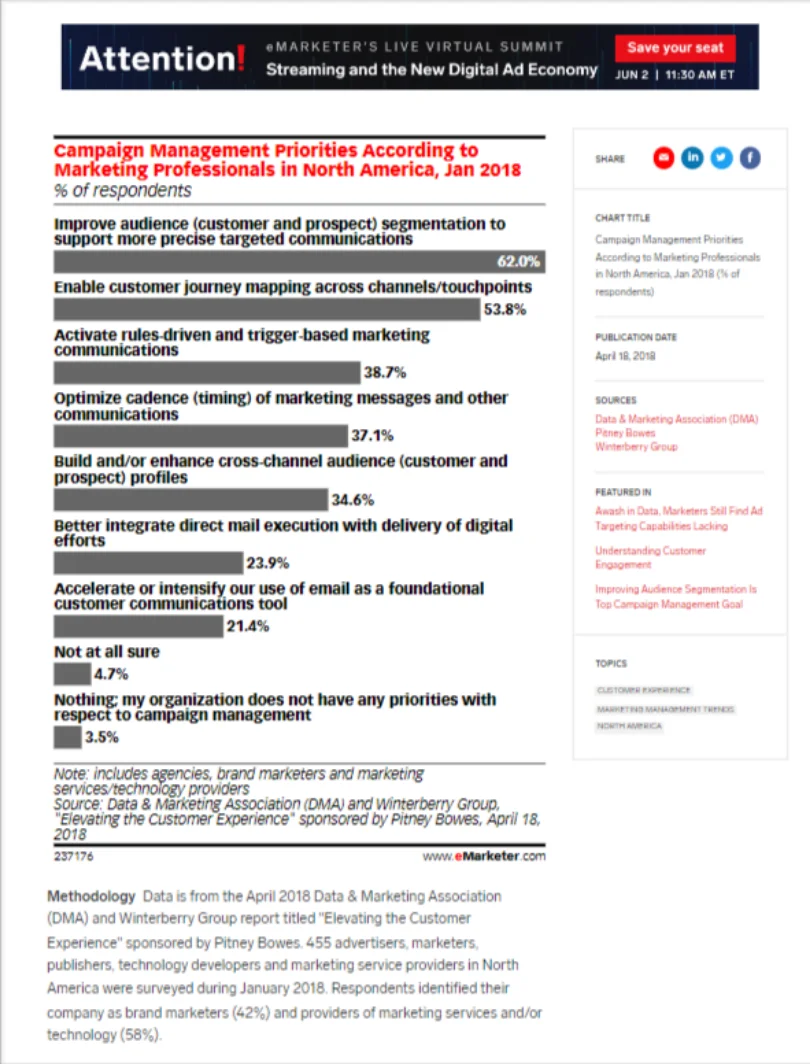
Here are few scenarios where businesses use market segmentation for personalization:
- Designing landing pages to target different customer types. Some landing pages target new visitors, like lead capture pages or click-through pages to collect information. Others, such as long-form sales pages, target customers at the end of the conversion funnel to persuade them to buy the product.
- Creating new product packages for different customer types like silver, gold, and platinum club membership.
- Designing different email campaigns with custom headlines, content copy, and CTAs aiming at different customer types to improve response and click-through rates. According to Experian, personalized emails produce six times more transaction rates.
- Using the previous search and watch history to show personalized recommendations like on YouTube & Netflix.
- Using cookies and data from other apps to show highly relevant ads to different user types like Facebook and Instagram.
3. Explore New Product Adoption & Market Acquisition Opportunities
Another important use of market segmentation is introducing your product to the right people and researching how upcoming products can capture new market segments.
It provides the data to fuel your R&D process and helps allocate resources at the proper places.
Suppose you run the following survey to collect feedback on a newly released product.
- What is your age?
- Please specify your gender.
- What is your current employment status?
- What do you use the product for?
- According to you, what should be the ideal price for this product?
- Does this product have all the features and functionalities you expected?
- How would you improve this product?
You can group responses based on the same age, employment status, product usage, or any other combination of variables.
Once done, optimization strategies can be drawn for the same segments, like customers with the highest LTV (lifetime value) or the criticality of the issue.
Case Study – Infiniti Research leverages market segmentation to explore growth opportunities for its client dealing in Neuromonitoring devices
A client of Infinity Research was looking to create new products and acquire new market segments. The biggest challenge they were facing was to gain data from different markets and introduce their products effectively.
Infiniti Research decided to use market segmentation strategies to identify various customer segments, address their demands, and find new ways to reach them.
The research provided the following benefits to the client:
- It helped find niche market segments to position the products.
- Identify the competitors and design effective marketing campaigns.
- Seamlessly develop products and services to reach niche market segments.
4. Plot & Compare the Journey of Each Audience Segment
A customer journey map outlines the path a customer takes as they move from one stage to another during their buying journey, as shown in the image below:
Discover how to create a customer journey map and download the template here.
Interestingly, the map denotes the journey of a customer persona, which is an imaginary identity representing a group of people that takes the same path.
Here is an example of customer persona:
| What to design your customer journey maps? Take a look at our Comprehensive Guide on Customer Journey Mapping and download your free journey templates. |
So, to create journey maps for different customers, you need to understand how different people behave and act along their journey.
And this is where you need market segmentation to know your audience types.
Market Segmentation is needed to create a customer persona, which helps to design customer journey maps.
Once the maps are drawn, you can visualize how different customers behave at different stages, such as finding your website on the internet or using different channels to contact customer services.
It helps to broaden your optimization process to create an effortless buying experience for every segment.
Types of Market Segmentation
Numerous variables separate one customer from another, so it’s necessary to have some broader categories to simplify the segmentation process.
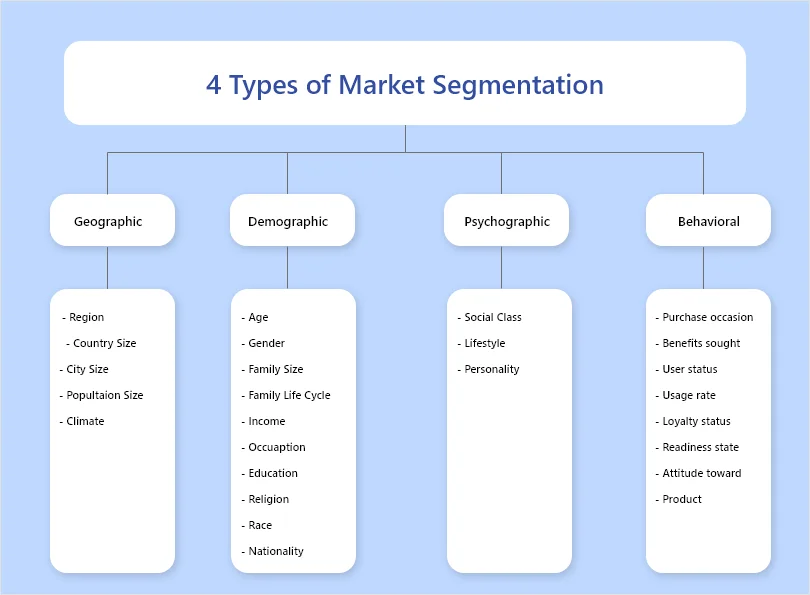
So, here are some major market segmentation types you can use to create customer segments at your end:
- Demographic Segmentation
Demographic segmentation breaks down the population into different groups based on their personal characteristics, such as:
- Age
- Sex
- Ethnicity
- Gender
- Family Structure
- Level of Education
- Children
- Marital Status
- Religion
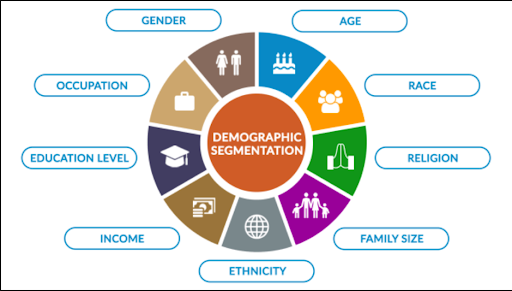
- Firmographic Segmentation
While B2C brands usually use the above traits to segment and target users, firmographic segmentation is used to group B2B customers based on organizational attributes such as:
- Income
- Experience (in years)
- Location
- Company Size
- Status
- Industry
- Executive Title
- Sales Cycle Stage
It helps to create unique value propositions for each organizational segment and improve marketing campaigns.
- Generational Segmentation
Another sub-categorization of demographics is generational segmentation which divides people based on their birth period. So, instead of age as an exact number, it groups people into different generations.

For example:
- Baby Boomers: born 1946 to 1964
- Generation X: born 1965 to 1980
- Millennials: born 1981 to 1996
- Generation Z: born 1997 or after
- Generation Alpha: born 2010 or after
Different generations have different life experiences based on the changes around them and technological advancements. Segmenting your customers according to age groups can help you fine-tune your campaigns and ads.
For example, millennials and GenZ are generally more receptive to Facebook ads than the generations before. In the same way, healthcare products appeal more to senior citizens.
- Geographic Segmentation
Geographic segmentation ties the audience with their physical location and area. It includes grouping the market based on the following traits:
- Country
- State
- Region
- City
- Postal code
- Population density (urban, rural, or suburban)
- Economic status
- Regional climate
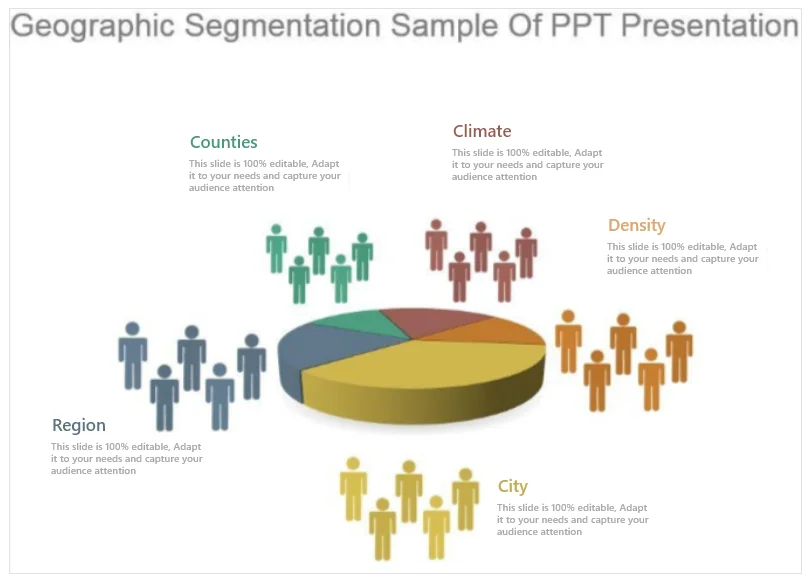
Geographic factors affect people’s behavior, habits, and interests. Different locations have different climates and topography that give rise to individual needs and preferences.
So, geographic segmentation let’s you pitch the right product to the right people, such as mountaineering boots for hilly regions or raincoats for places with heavy rainfalls.
- Behavioral Segmentation
As the name implies, behavioral segmentation groups your target market according to their behavioral patterns as they interact with your business. You can use their motivations, actions, and preferences to create an immersive experience along the customer journey.
There are different sub-categories for behavioral market segmentation that focus on different customer attributes, as discussed below:
- Segmentation Based on Purchase Behavior
This type of segmentation examines and categorizes the users based on how they act while making purchasing decisions. Purchasing behavior depends on several factors, such as prices, surroundings, income, and available channels.
For example:
- Some customers may purchase from brands only when they have a discount coupon.
- Other users may compare extensive features before purchasing.
- Some prefer bulk purchases to save money and time.
Understanding how users decide to make purchases can help you deliver the correct messaging through the proper channels to increase engagement.
A consumer research study by McKinsey on changes in behavioral patterns due to COVID-19 shows the shift toward online shopping during the crisis. It means businesses also had to come up with platforms or ideas to sell their products online or risk losing revenue.
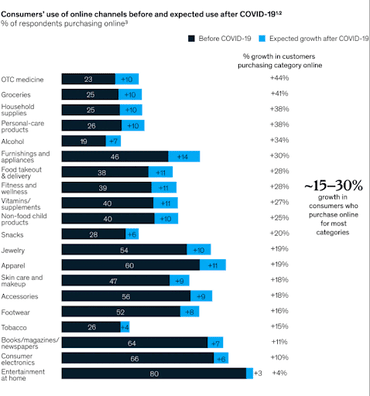
That’s why tracking your customers’ purchase patterns is imperative so you can also spot the shift and make the necessary changes.
- Seasonal or Time-Based Segmentation
Customers who purchase at specific times of the year, such as holidays or special occasions (weddings), come under seasonal market segmentation.
Many brands leverage time-based shopping to improve customer engagement and sales, like happy hours in a bar or a clearance sale on Black Friday.
For example, McKinsey’s report on holiday shopping behavior that categorizes consumers based on their primary concerns shows that:
- 46% of people get confused about what to buy on holidays.
- Another 44% try to budget their purchases to control expenses.
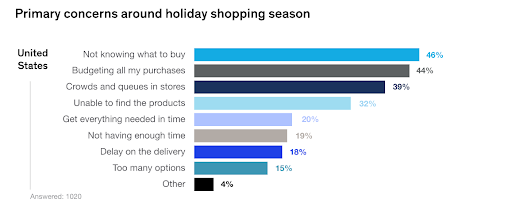
To target these two segments, you can use their purchase history to show relevant product recommendations. Then, push them towards conversions with custom discounts, memberships, and other saving options.
Pop-up tools such as Picreel can help you engage visitors based on their on-site behavior. It lets you cash in on seasonal advertising and drive more conversions quickly to boost sales.
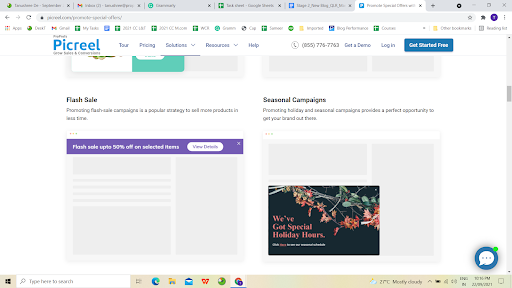
- Value or Transactional Segmentation
Value or transactional market segmentation takes into account the number of purchases, purchase frequency, and average order value to estimate the revenue potential and loyalty of the customer.
The customers can then be segmented based on different transactional traits.
For example:
- Regular customers who haven’t made a purchase in the last three months carry a high risk of churn.
- Customers with LTV above $15000 are high-value and loyal customers. So you can retarget with personalized services and offers.
- Segmentation Based on Usage Status
This type of segmentation places customers in groups according to their current spot in the conversion funnel. It’s a fantastic way of finding customers’ challenges at different stages of their journey and offering them unique solutions.
Usage-based segmentation includes the following groups:
- Ex-users: Who used the product in the past but don’t use it anymore.
- Current users: Who are currently using the product.
- First-time buyers: Who are using the product for the first time.
- Prospects: Potential customers who have shown interest in the product.
Examples of status-based segmentation:
- Reaching out to the ex-users via surveys to learn about product issues and their reasons for discontinuing the product.
- Adding a smooth onboarding process for first-time users to improve product adoption.
- Psychographic Segmentation
Psychographic segmentation explores more nuanced traits of customers’ personalities, perceptions, interests, and beliefs. It separates people based on their way of living and values, like:
- Hobbies
- Activities
- Beliefs
- Social life
- Goals
- Involvement in the community
This makes it easy to position your products and services in the market when you know how your target audience thinks. You can explore what your customers like and spend on to find new products and market opportunities.
- Price Segmentation
Even in 2025, price still ranks among the top factors influencing consumers’ purchasing decisions.

Since each customer is different, it makes sense to provide pricing options to different customer types based on their budget or requirements.
With price segmentation, you can offer different customers the same or similar product at different prices, like:
- Customer Segmented Pricing
In this method, the company decides the product prices based on customer segments such as age, family type, region, etc.
- Product Tier Pricing
In product tier pricing, the prices are set according to the different versions of the same product. For example, creating product tiers like standard, enterprise, and individual.
- Technographic Segmentation
Technographic market segmentation lets you group people based on the usage and ownership of technology in their life. It’s a powerful market segmentation technique for businesses dealing in technological solutions like Saas, IT, research, CRM, etc.
Here are a few cases of technographic segmentation:
- By grouping customers based on technology, you can visualize which prospects are shifting toward the solutions offered by your company.
- You can create a list of prospects using older technologies than your offering and create value propositions to target them.
Real-Life Examples of Market Segmentation
With categorization out of the way, let’s look at the use of target segmentation by real-life brands:
Examples of demographic segmentation:
- Google Adwords’ demographic targeting dashboard to help you personalize the ads further.
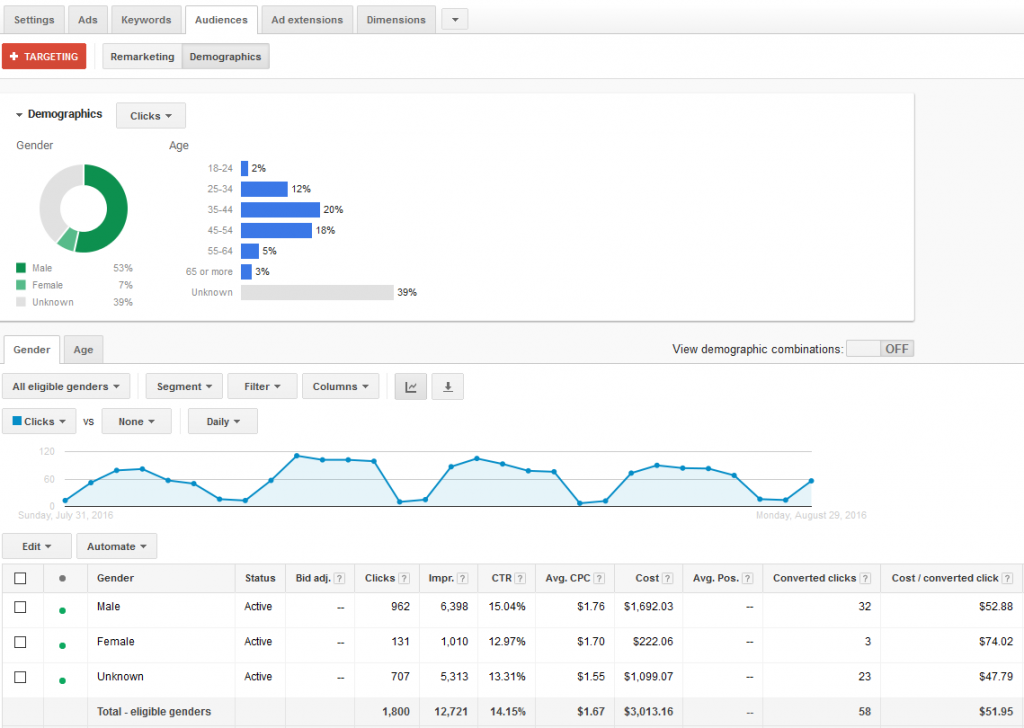
- Abbott Nutrition’s age-based product targeting.
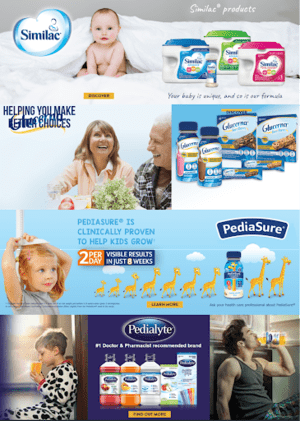
Examples of firmographic targeting:
- The value proposition for Microsoft POS software targeting different industry types
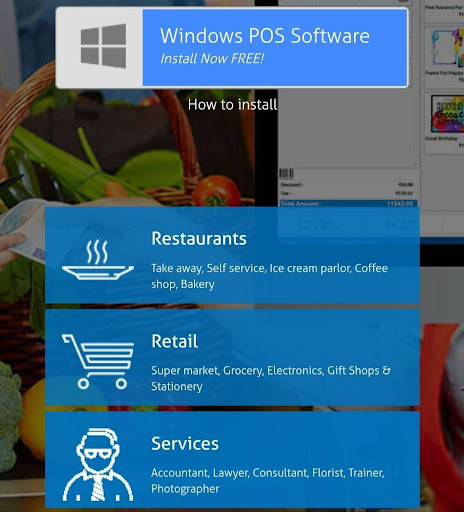
- Mastercard’s focused messaging on its website to entice companies based on their size

Examples of generational segmentation:
- La Croix used the Instagram influencer campaign to promote its zero-sugar carbonated drinks over unhealthy soda to health-conscious millennials. By encouraging young followers to use hashtags like #LiveLaCroix and #LaCroixlove and sharing their product experiences on Instagram, the brand increased its sales by 45% in a single year.

- British Army’s witty recruitment campaign targeting millennials’ idiosyncrasies.
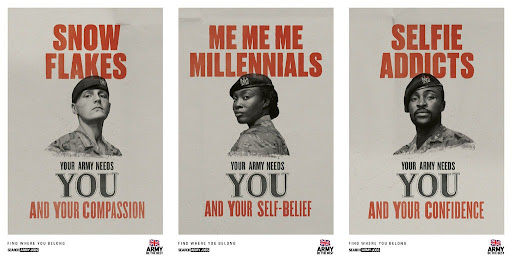
Examples of geographic segmentation:
- Location-based ad targeting on Facebook and other platforms.

Examples of psychographic segmentation:
- Johnie Walker’s White Walker Scotch Whisky was introduced during the final season of the Game of Thrones TV series to entice fans.
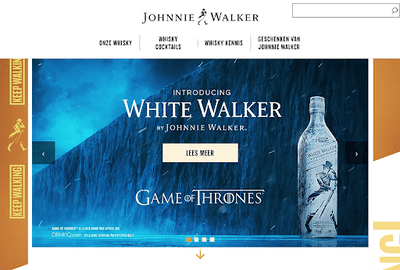
- Harley Davidson’s messaging has always positioned itself among the rebellious, thrill-seeking bike lovers of America.

Examples of Price Segmentation
- Customer Segmented Pricing – A typical example of this type of pricing is an offer based on age, like a student or elderly discount.

- Product Tier Pricing – Creating product tiers like standard, enterprise, and individual.
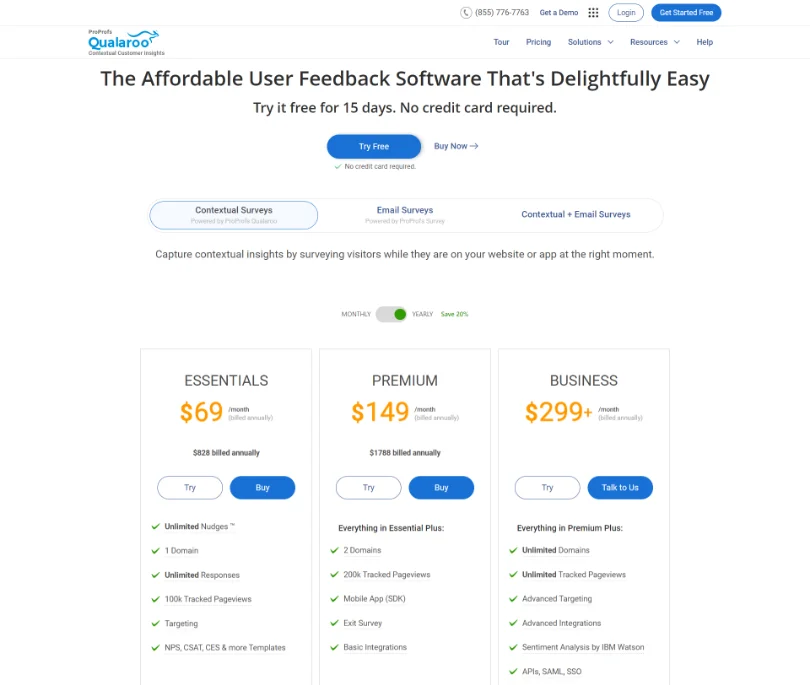
FREE. All Features. FOREVER!
Try our Forever FREE account with all premium features!
40+ Market Segmentation Survey Questions to Use in 2025
1. Demographic Survey Questions
- Please specify your age
- Please specify your gender
- Select your highest level of education
- What is your current occupation?
- What is your monthly household income?
- What is your current marital status?
2. Firmographic Survey Questions
- What is the name of your company?
- Where is your company’s headquarters located?
- Please specify the number of employees that work in your company.
- What is your job title?
- In which location do you work?
3. Psychographic Survey Questions
- Which activity do you prefer in your free time?
- Which other physical activities do you take part in?
- Where is your dream holiday destination?
- Please rate the following as per their priority in your life? Family, work, or your social life?
- Are you happy with your current work-life balance?
- Do you describe yourself as an optimist or a pessimist?
- Have you ever boycotted a brand? If so, which brand and why?
- What influences your purchase decision more – price or quality of the item?
- How often do you give to charity?
- How do you travel to work?
- How many hours do you spend on social media like Facebook, Instagram, etc.?
- How do you do your monthly grocery shopping – online or through outlets?
4. Behavioral Survey Questions
- Have you heard of [product name or category] before?
- How would you feel if [product name] was no longer available?
- How often do you use [product name]?
- How long have you been using [product name] for?
- When was the last time you used [product name]?
- How do you search for the products you want to buy?
- According to you, what should be the ideal price of the [product name]?
- Please rate the following product features according to their importance to you.
- Describe [brand name] in one sentence.
- How do you do your Holiday shopping?
5 Benefits of Market Segmentation
With what and why out of the way, let’s quickly look at some of the benefits market segmentation provides for marketers, advertisers, and other teams:
- Create Buyer Personas
One of the most significant advantages of target segmentation in business is creating different user personas. Collecting data about your customers’ preferences, behavior, and issues can divide users into groups with the same traits and problems.
Combining this data with each segment’s spending potential and acquisition cost, you can create buyer personas that depict the behavior of your highest-paid clients and those with significant purchase potential.
Case Study – How Metlife used custom segmentation to redefine its target customer personas
In 2015, Metlife started segmenting its customer base to improve competitive targeting and provide better services.
Earlier age was a significant demographic factor that helped insurance companies target clients with relevant services and products.
But Metlife decided to include other market segmentation types. With targeted surveys, the team collected in-depth data on several demographic, firmographic, and attitudinal variables.
The company then started segmenting these customers to get a more refined picture of Metlife’s customers.
Here is an example of five distinctly identified customer segments:
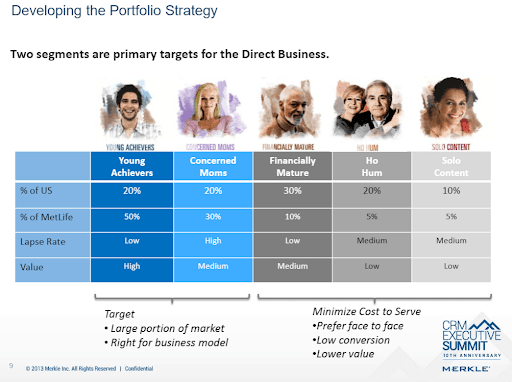
With these results, Metlife committed to a data-driven approach to create differentiated value propositions for each customer type.
Watch: What comes first – Persona research or market segmentation research?
- Create Products Tailored for Different Segments
Market segmentation provides a data-driven and customer-focused approach to developing new products and services.
Instead of developing a product and finding the right audience, it helps to understand the needs of different customers and develop the right products.
For example:
- Geographic segmentation makes it possible for a clothing line to understand the cultural backgrounds of different locations and release outfits that appeal to the population.
- Regarding psychographic segmentation, restaurants use different menus for people who eat only a plant-based diet and others who eat meat.
Here is a suitable example of geographic and cultural segmentation from McDonald’s – Big Mac in America with beef and a slightly different branding without beef in India, i.e., the Maharaja Mac.
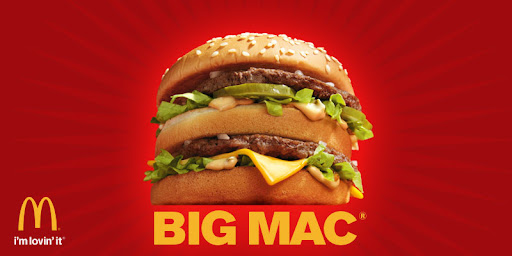

- Allocate Resources and Market Budget Properly
Identifying key customer segments lets you allocate resources at the right places for maximizing ROI.
Whether you want to retarget customers with your ads, improve the effectiveness of your mail campaigns, or find new market opportunities, business segmentation research does it all.
Once you know who your customers are, their fears and motivations, and how they act along their buying journey, you can use these data points to streamline your marketing efforts.
Case study – Lego Group used market segmentation to create customer personas to run successful social media marketing
Lego faced a massive challenge to market its products over social media. So, they decided to use customer behavior analysis to build better relationships with customers and generate new product ideas.
Lego used six distinct user personas to segment its customer based on purchase and usage rates:
- Lead Users: People Lego actively engages with on product design
- 1:1 Community: People whose names and addresses they know
- Connected Community: People who have bought Lego products and [have] also been to either a LEGO shop or a Lego park
- Active Households: People who have bought Lego products in the last 12 months
- Covered Households: People who have bought Lego products once
- All Households: Those who have never bought Lego products
Lego found that the first three segments are the ideal targets to initiate social media interactions for encouraging them to become promoters.
The result: With constant social media campaigns and leveraging customer insights into their product development, Lego is now the biggest toy manufacturer in the world.
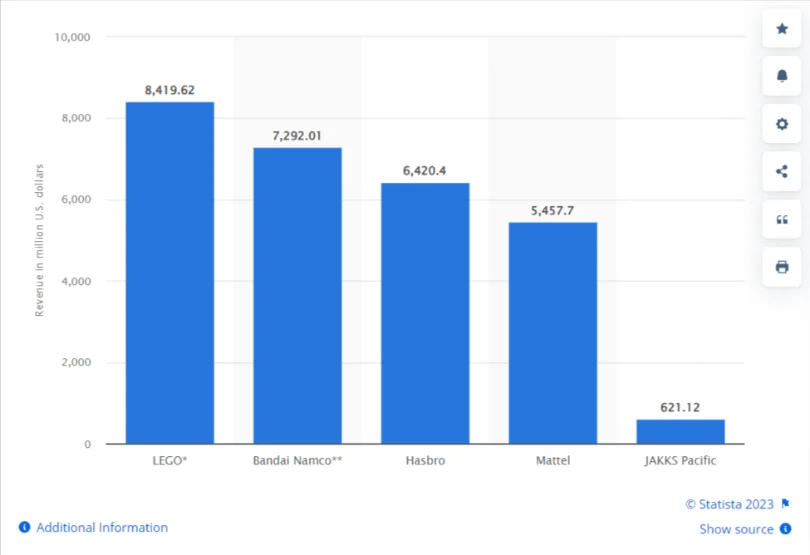
- Customer Retention
It’s far easier and less expensive to retain existing customers than to acquire new ones, which is why customer retention is a primary goal for every business.
Market segmentation techniques give you more refined insights into different customer segments. Instead of looking at the customer base as a whole, you can understand the problems and issues of each customer type and provide relevant solutions to retain them.
For example:
- Segment users based on their purchase behavior to see which segments are more prone to churn and reach out to them.
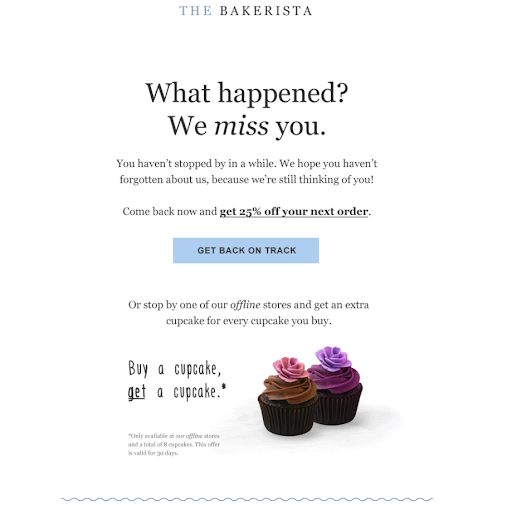
- Use the RFM (Recency, Frequency, and Monetary value) analysis to differentiate between the customer segments loyal to your business, which have the potential to upscale, and those likely to churn.
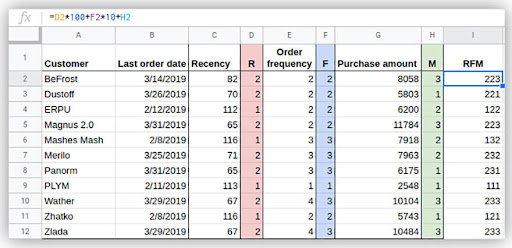
- Use demographic and geographic segmentation to determine which groups are and aren’t satisfied with your product. Then, use surveys to find the reasons behind their behavior to come up with relevant solutions.

- Increase Conversions
Let’s get down to the ultimate prize of market segmentation – more conversions. By dividing your customer base into smaller groups, you can design highly focused strategies to target different segments.
This makes it easier to personalize the interactions and optimize the overall experience.
Here’s how:
- Running sales promotions on Black Friday in America, Chinese New Year in China, and Diwali in India to maximize sales.
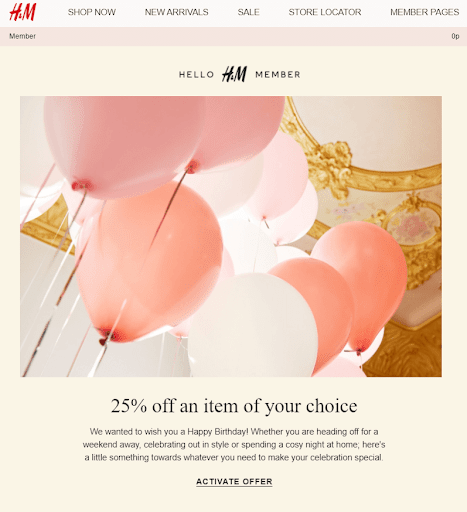
- Creating ads that appeal to seasonal or climate characteristics.
- Offering a basic free plan or first-time discount for startups and a higher price with advanced product features for bigger businesses. Here is an ad from Avocode that appeals to students.
- Creating different product models with different features based on types of users like professionals, gamers, and office-goers.
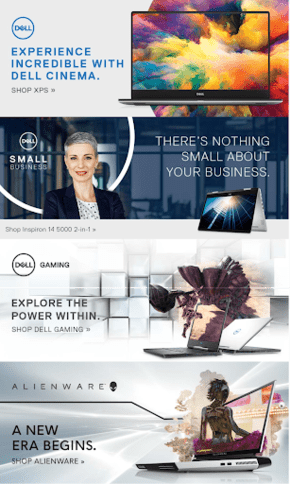
Four Easy Steps to Conduct Market Segmentation Research
With so many approaches, market segmentation research can be tricky, so we have presented four easy steps to get you started.
1. Analyze the Existing Customers
Start by analyzing the behaviors, interests, actions, and needs of your existing customers and visitors. It will help you gather the data for segmentation.
Here are few ways you can collect the required information:
a. Conducting Surveys
Surveys are excellent tools for collecting user insights at different stages of their journey. How?
- You can collect segmentation data from different customer types.

- Analyze customer behavior using exit-intent surveys, product opportunity surveys, and market research surveys.

- Get feedback on your products and services using NPS surveys to identify the risk of churn and customer loyalty.

- Conduct pricing analysis to gain insights into how customers view your current pricing structure.
- Deploy customer satisfaction surveys after purchase to gauge the shopping experience.

Here are few data points you can collect using surveys:
- Date of birth
- Region
- Family status
- Interests
- Fears
- Problems
- Needs
- Characteristics
b. Analyzing the Analytical Data
Next, look into your analytical data to find how customers behave on your website, mobile app, or product. It will help you find the most interacted web pages, most active traffic sources, goal completion rates, bounce rates on various pages, and other metrics.
c. Consolidating Data From the Sales & Service Teams
Sales teams and service executives are the richest information sources of value segmentation for your audience since they are the closest ones to the customers. You can gather the following data from these teams:
- Lifetime Value
- Last purchase (risk of churn)
- Current product usage status
- Purchase potential
- Acquisition cost
2. Group the Customers Into Segments
Now that you’ve all the required information in one place, start creating customer segments for different variables.
Here is an example of different segmentation types:
| Segmentation type | Variable | Identified segments |
| Geographic | Country | Canada, North America, England |
| City | Quebec, Seattle, Los Angeles, London, Liverpool, Manchester | |
| Population density | Urban, suburban, rural | |
| Demographic | Age | Boomer, Millennials, GenZ |
| Level of Education | Grade school, high school graduate, university graduate | |
| Gender | Male, female, non-binary | |
| Marital Status | Single, Married, Divorced, separated, widowed | |
| Income | Under $10,000;10,000- 24,999;25,000- 39,999;40,000- 59,999;55,000+ | |
| Experience (in years) | Less than 1 year,1-3 years4-5years5-8 years8+ years | |
| Industry | IT, automobile, marketing, Manufacturing | |
| Psychographic | Lifestyle | Student, athlete, office-goer, |
| Behavioural | Lifetime Value | Less than $299,$300-$499;$500-$1000;$1000+ |
| Current status | User, ex-user, prospect, first-time visitor, repeat visitor, | |
| Risk of churn | High, medium, low | |
| Usage rate | Regular user, light user, rare user |
3. Identify the Target Segments
Here we are trying to group customers into more granular segments according to the right product fit. Different products or activities will attract different customer types.
Let’s take an example. Suppose you see that for New York, the customers with the highest LTV of $5000 comprises people between the ages of 35-45 years working in the software industry with an annual income of above $40000.
In this case, you can explore options to pitch new products to this particular segment to increase conversions since these particular people already provide better returns.
One of the most effective methods to select your target segments is the BMC (Business Model Canvas) module. It sketches key activities or products, primary distribution channels, main customer segments, and potential revenue stream, among other areas. Here is an example of BMC for a bike courier service business:

Group your customer into small groups to find the right product-market fit.
4. Design Marketing Plans to Reach the Desired Audience Segments
Once you know your target market, you can start designing promotional and marketing strategies to entice each segment.
You can create landing pages, email campaigns, door-to-door product demonstrations, targeted online ads, and other mediums to reach out to these segments to increase product adoption and conversions.
5 Common Market Segmentation Mistakes to Avoid
Market segmentation is a long process, and sometimes common mistakes can skew results for an entire campaign. It affects your ability to create clear segments making it harder to identify the correct targets.
Here are some common mistakes you can avoid to get the best results:
1. Creating Segments That Are Too Small
One of the biggest mistakes while doing market segmentation is creating hypergranulated segments. It happens when you try to group customers on every little detail. The truth is each customer is essentially different, and if the segmented group is too small, it may lose its potential.
That’s why it’s crucial to identify which variables can contribute towards achieving desired goals like conversions. In this way, you can take only critical variables to form meaningful segments while ignoring the others.
For example, if you’re trying to improve conversions, begin by segmenting buyers based on their LTV. Then, identify the potential channels that bring the maximum revenue. From there, you can move towards adding demographics or geographical variables to find the correct segment.
2. Not Gathering Sufficient Data
If gathering too much data is a crime, not gathering enough data is a sin.
If you don’t have enough data, you may miss out on previously unidentified customer segments that have the potential to be your niche target audience.
Suppose you observe that your highest paying customers for a product or service belong to the age of 20-35 years and earn between $18000 – $30000 a year.
So should this be your target audience?
Wait, let’s look at the analytical data. By analyzing Google Analytics data and using survey feedback, you find the highest bounce rate is observed for the people from the income group below $8000 as they cannot afford the product price.
Now, calculate if this low-income group has the purchase potential in the vicinity of the revenue generated by the other group or not.
Let’s say it does; you can now run price analysis surveys to develop more flexible pricing tiers to increase conversions.
If you hadn’t looked into the data, you would have lost this opportunity to acquire this new customer segment. So, collect every data point to look for distinguishable patterns.
3. Not Taking Time Into Account
Another big mistake in market segmentation analysis is leaving time out of the equation. Time has a huge impact on your customers’ behavior and actions.
For example, some customer segments may be more receptive to email campaigns during the weekend, while others may provide a better response rate in the weekday afternoon.
In the same way, people who come under the lower-income group are more likely to use the discount coupon from your sales ads campaign during the festive season than other times of the year.
That’s why it’s essential to note the time of engagement while segmenting your customer base.
4. Relying on Old Segments for New Campaigns
The consumer market is ever-changing with new technological advancements, and it influences both the buying patterns and behavior of the customers.
So using old segment data and methods for market segmentation is a big mistake.
For example, new engagement channels offer opportunities to acquire new markets. In this case, you need to reassess the audience type using this channel and compare the data with other channels to evaluate which has a higher potential of producing ROI. It’s also possible that some customer types may have abandoned other interaction channels and are now using the new one.
That’s why it’s necessary to take new market trends into account while creating customer segments.
5. Focusing on Segments Instead of Revenue Potential
As expressed in the first point, concentrating solely on segments can result in wrong conclusions. Keep in mind that the ultimate goal of the entire market segmentation exercise is to increase conversions.
For example, a specific audience type may be generating a considerable number of leads through your campaigns. Still, it does not mean it’s your target audience. Look further into the data to gauge the effectiveness of the efforts by calculating the lead to conversion ratio and cost per conversion.
That’s why, after you’ve identified the customer segments, the next step is to calculate the purchasing power to identify the actual target market before you start designing your marketing campaigns.
FREE. All Features. FOREVER!
Try our Forever FREE account with all premium features!
Start the Hunt for High Yielding Customer Segments
You can achieve so much by looking closely at your target audience, making market segmentation a crucial part of any successful business strategy.
You can hit the right chord with your customers and prospects by categorizing the large market into smaller chunks based on specific attributes and needs. It means better conversions and revenue.
But there’s a catch!
Market segmentation is an iterative process requiring continuous adjustments and evaluation as the market changes.
So start with basic segmentation based on geographic and technographic characteristics. Once you have well-defined groups, you can use survey tools like Qualaroo to collect more information on customers from different regions to map their needs and problems.
It will give an in-depth view of the solutions you can provide them. As you build upon these customer personas, try incorporating their journey stages and creating customer journey maps.
Then you can use the right channels and tailored personalized strategies to target desired segments with the right message at the right time to improve conversion rates.
So, use the blog as the basic handbook for creating a sustainable market segmentation model in your business today.
FAQs
- Why is market segmentation important?
Market segmentation helps you divide your audience into groups based on specific attributes like age, lifestyle, purchase behavior, etc. It lets you map each segment’s pain points, issues, grievances, and delights so you can optimize your products and build new ones to suit their needs. It also lets you identify the customer segments that bring in the most revenue to target them with personalized campaigns to explore new opportunities.
- What are the 8 main types of market segmentation?
Market segmentation is broadly classified into the following types:
- Demographic Segmentation
- Firmographic Segmentation
- Generational Segmentation
- Geographic Segmentation
- Psychographic Segmentation
- Behavioral Segmentation
- Price Segmentation
- Technographic Segmentation
- What are the 5 main different segments for demographics?
Demographic segmentation groups people based on any of the following attributes:
- Sex
- Ethnicity
- Gender
- Level of Education
- Marital Status
 Tips
Tips
We’d love to hear your tips & suggestions on this article!
FREE. All Features. FOREVER!
Try our Forever FREE account with all premium features!


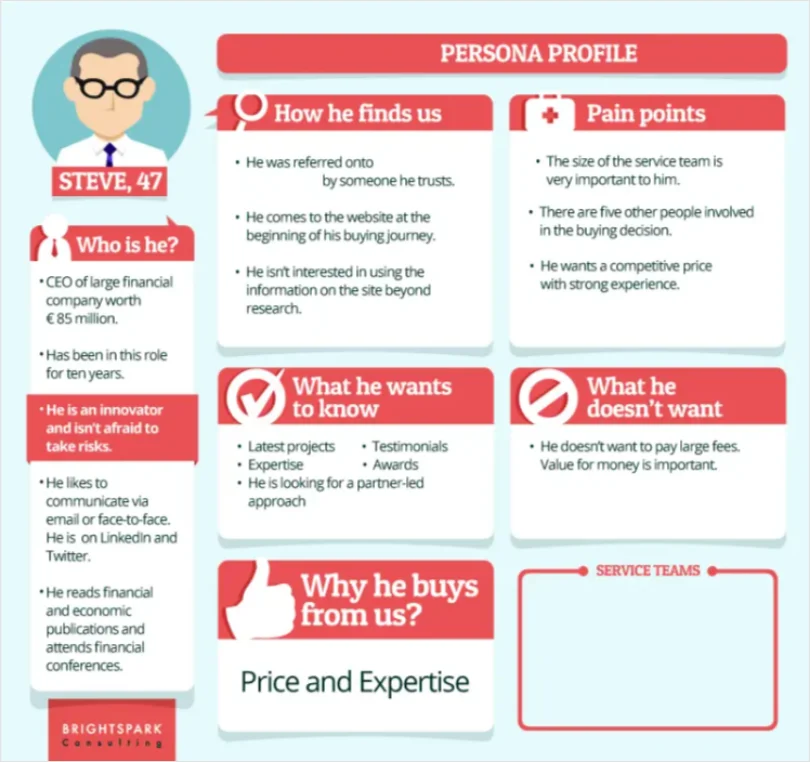
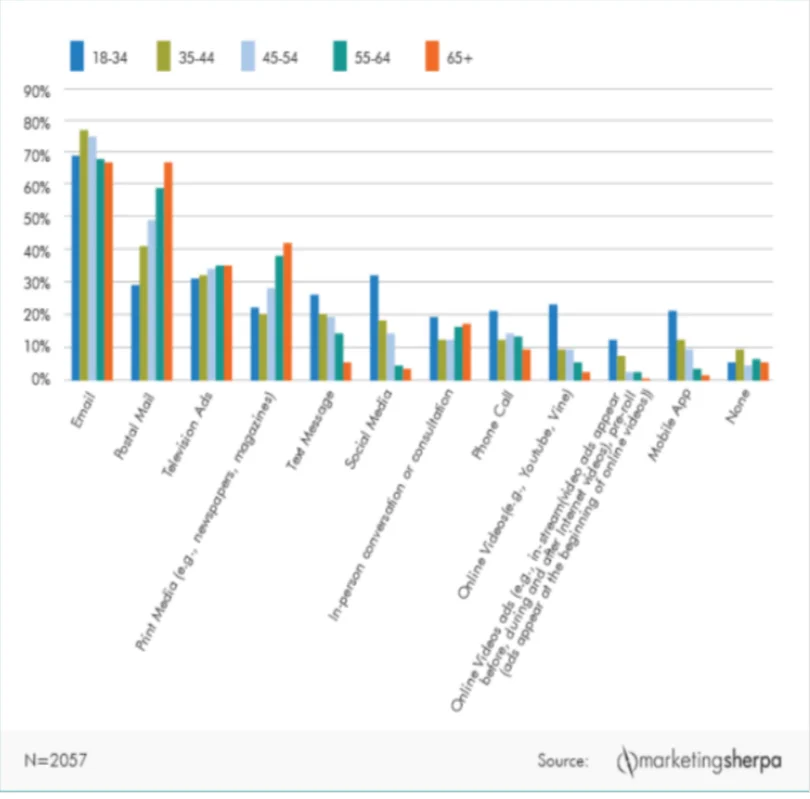
 We'd love your feedback!
We'd love your feedback! Thanks for your feedback!
Thanks for your feedback!






